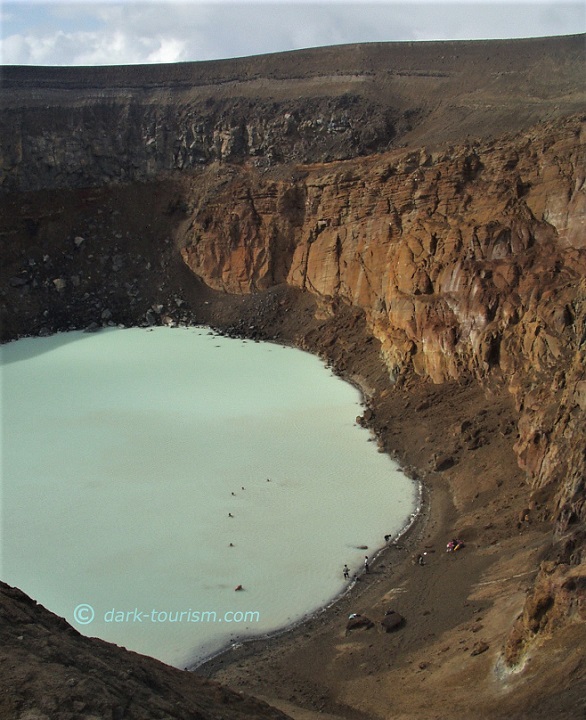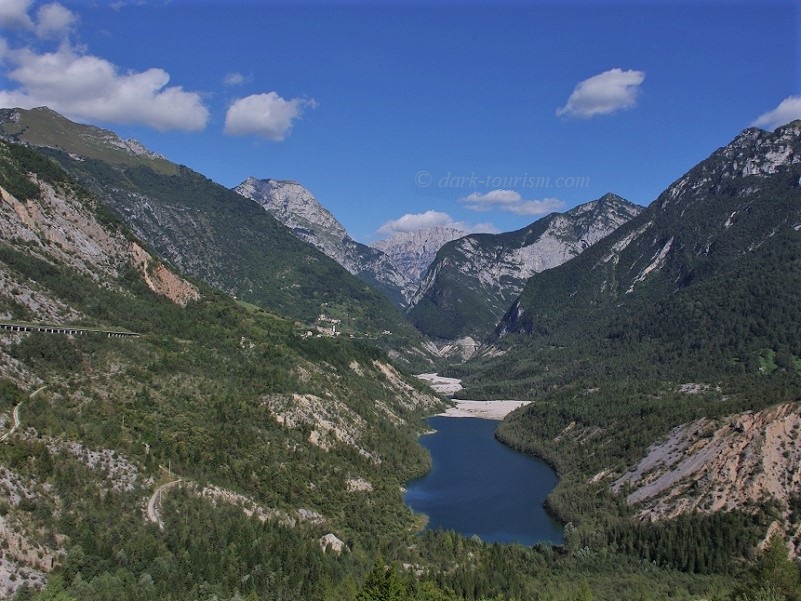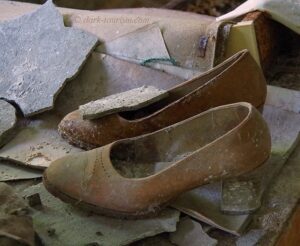As announced in the previous post and the latest newsletter, today I bring you the other one of the joint winners of our latest theme poll, after DT & spheres. So, now to lakes.
The first category of lakes with a dark association that I thought of when I came up with this theme was volcano crater lakes, such as this one:

This is Nakadake crater, part of the Aso volcano caldera on Kyushu, Japan. This crater is the system’s most active spot, having erupted periodically over the past century or so. Sometimes the water in the crater is blown out by such activity but most of the time it just sits there fuming away sulphurous gases. Still, it’s a nice and eerie sight.
And here’s another such crater lake, this time in Indonesia:

This is Kawah Ijen, the world’s largest acid lake, in fact the concentration of sulphurous acid in the water also makes it one of the deadliest lakes in the world, which was sadly proven, when a few years back a tourist fell in and was killed. Otherwise Ijen is infamous for the sulphur mine on its shore, just about visible on the left of this image. Here, hardy locals set alight the sulphur deposits and channel the liquid sulphur into moulds, and after it has solidified, they break it into chunks and carry it up the crater wall and onwards downhill to sell the stuff. At night, the burning sulphur produces otherworldly blue flames. It’s a truly infernal sight!
Here’s yet another sulphurous crater lake, this time in Iceland:

This crater, called Viti (meaning ‘hell’ in Icelandic) was created in an explosive event in the late 19th century and is part of the larger Askja volcano caldera. The water inside the crater is heated geothermally to a balmy 25 degrees centigrade and is not too acidic. When I visited the place as part of a group tour of this very remote area of the interior highlands of Iceland, we even went for a swim in these waters – after a steep scramble down the side of the crater. You have to go into the water naked, or else any swimming garments you’d wear would forever stink of rotten eggs. (The towels we used to dry off afterwards also held on to their sulphurous stink for about a dozen washes afterwards.)
Viti is right next to a much larger, deeper and colder lake called Öskjuvatn:

The people standing on the rim between the two lakes give a bit of a sense of the dimensions of this barren place. Öskjuvatn lake also holds a dark secret of its own. In 1907 two German scientists went to study Askja and rowed a boat on to Ösjkuvatn … and then they disappeared. No trace of them was ever found – it was as if the lake had simply swallowed them up!
Next up is a lake less directly linked to volcanism, but also potentially very deadly:

This is Lake Kivu in Central/East Africa, seen from the Rwandan side; across the lake is the DR Congo. Kivu is one of only a very small handful of “exploding” lakes, where so-called “limnic eruptions” have occurred. That’s a rare phenomenon, when methane or carbon dioxide dissolved in the depths of the lake’s waters is suddenly released by a lake “overturn”, thus suffocating all human (and animal) life on the shores with a deadly gas. This has happened at two other such lakes in Cameroon in the 1980s and thousands were killed in their sleep by the ground-hugging gas. Geological research at Lake Kivu showed that it has “overturned” every few thousand years. Today, about two million people live on its shores, so there’s a danger of a real large-scale catastrophe here. Moreover, just to the north of its shores sits one of the world’s most active volcanoes, Mt Nyiragongo, and it is feared that an eruption creating a lava flow reaching the lake could trigger such an “overturn”.
Back up north, this is Lovatnet in Norway (the image already featured above as the lead photo):

Again, this looks just very scenic and serene, but this lake, too, has been deadly, twice, in the 20th century, namely when huge rockfalls/landslides from the steep slopes of Mt Ramnefjell crashed into the water, creating massive tsunamis that washed away entire villages on the lake’s shores.
Next up is a lake that still shows clear evidence of an earlier catastrophic event:

This is part of Sprit Lake, in Washington State, USA. The bleached layer of bits floating on the surface are all dead trees, blown down in the cataclysmic eruption of nearby Mount St Helens in 1980. Nature around the volcano is recovering, but these dead trees remain as a reminder of the violent forces that nature has in store.
But it doesn’t always have to be nature to make a lake dark and dangerous; this one is artificial, filling a former open-cast copper mining pit:

This is Berkeley Pit in Butte, Montana, USA, where water has filled a former copper mine crater. The danger here is the chemicals dissolved in the water; if the water rises too high it might contaminate the area and its aquifers, hence it is being closely monitored. At the same time it’s become a minor tourist attraction and a tunnel was dug into the side of one slope that leads to a viewing platform, from where this photo was taken.
And here’s another artificial lake – or rather, what’s left of it:

This is the site of the Vajont disaster of 1963. Vajont dam in northern Italy was at the time the highest dam for hydroelectric power generation at 262m, but on 9 October 1963, when a landslide from Monte Toc on the banks of the reservoir created by the dam crashed into the water. The sudden displacement of millions of tonnes of water triggered a huge tsunami that overtopped the dam and sent a deadly tidal wave down the valley towards the town of Longarone, killing ca. 2000 people. The wave also swept up in the other direction affecting yet more villages, such as Erto, which is just about visible in this image in the distance. The dam, which survived the disaster almost unscathed, was afterwards given up and of the former reservoir that filled the valley only a small residue lake remains next to the mounds of earth from the landslide, seen here on the right. Since it had been known that Mount Toc was unstable but warnings about this were ignored by the authorities and the dam operators, this was only partly a natural disaster but also partly man-made.
A totally human-made disaster was that of the dessication of the Aral Sea in the former Soviet Union, now shared between Kazakhstan and Uzbekistan. Here’s a view of the former lake from the ex-harbour of Aralsk, Kazakhstan.

Despite the designation “Sea”, the Aral Sea is/was a lake, and was once the fourth largest such body of water in the world by area. Then, from the 1960s onwards, the two rivers feeding the lake were tapped on a massive scale for irrigation, primarily for growing cotton. Less and less water reached the lake and so it began to shrink, raising the salinity of the remaining water, which in turn killed of all the fish. Hence the once thriving fishing industry of the Aral Sea also died. Moreover, the desert that formed where once there had been water became seriously polluted with chemicals left from fertilizers used in agriculture. The southern part of the lake is now almost completely gone, without any chance of it ever coming back. The smaller northern part in Kazakhstan, however, is slowly being replenished by means of a dam that prevents water from the Syr Darya river from flowing south (where it would just evaporate in the new desert). The water level of the North Aral Sea has risen enough for fish to return and the Aralsk fishing industry is slowly being revived.
Another Sea that is actually a lake, and, again, one that is shrinking, is the Dead Sea between Israel and Jordan:

This photo was taken from the top of Masada, a historic site on the Israeli shores of the lake – except that the waters have receded so far that you can barely make out the shores in the distance any more. As with the Aral Sea, it is the tapping of water from the River Jordan, the lake’s only inflow, again for irrigation, that made the Dead Sea actually die.
The Caspian Sea is also actually a lake, in fact the largest on Earth, and while its water levels have also fluctuated a bit over time, it’s not as such doomed like the Aral and Dead Seas. However, here the oil industry has left its nasty mark:

This photo was taken on the northern tip of what was then Artyom Island, but which has meanwhile been renamed Pirallahi (probably to bring it in line with Azeri place names), located ca. 30 miles (45 km) east of Baku, the capital of Azerbaijan. The Baku area on the Abşeron Peninsula in the Caspian Sea is where the oil industry really began. At the beginning of the 20th century this was the No. 1 oil-producing area in the world. It’s still going strong but over a century of oil extraction has left plenty of pollution and dereliction, like these old drilling platforms dotted over the sea, shipwrecks as well as old tanks and oil derricks on land. Normally the secretive Azeri oil industry does not welcome camera-toting tourists, but on my trip to the Caucasus in 2010, I had a guide and driver who were willing to take me to this forlorn spot, but we had to be discreet. I’ve heard from later would-be visitors, however, that they were denied access, so I was kind of lucky to get to see this close up.
Not all lakes are bodies of water, or at least not entirely water. Here’s a mud lake, also in Azerbaijan, namely near the fabled mud volcanos of Qobustan, south of Baku:

And there are salt lakes too, like this one in Chile:

This salt pan in the Atacama Desert of northern Chile, and simply called Salar de Atacama, is mostly covered in salt crusts, but there are the odd bits of open water in lagoons, where flamingoes sieve through the water feeding on tiny shrimps or crabs.
The most dramatic and largest salt lake I’ve ever seen is further north, in Bolivia, the legendary Salar de Uyuni high in the Andes (at almost 3500m above sea level):

This is in fact the largest salt pan in the world, which formed when a former lake dried out some ten millennia ago. When I was there it was at a time when it rains a little more than most of the year, forming a thin layer of water on the lake surface. This can give it a bizarre mirror effect, as in the above photo taken with a superzoom bridge camera at ca. 30x magnification.
Finally, there are also lakes where no water can exist at all, namely lakes of lava in volcanic craters. Permanent lava lakes are extremely rare (currently there are only about half a dozen dotted around the Earth), but at a time Kilauea volcano on Hawaii featured even two lava lakes, one at the main Halema’uma’u summit caldera and a second inside the Pu’u O’o cone in the eastern rift zone. I got a glimpse of the latter in 2015 on a doors-off helicopter flight over the area and shot this photo:

This lava lake is no more, though. During the May 2018 phase of intensified activity, the crater’s floor collapsed and the lava lake drained away. The lava re-emerged miles away from fissures and brought much destruction to the Puna region of the island, before in August 2018 all activity at Kilauea stopped for the first time in three decades. At Halema’uma’u activity recently resumed from 20 December onwards and a new lava lake has meanwhile formed there (see this site for current information and images). Whether lava will also return to Pu’u O’o is unclear. It’s probably unlikely, but cannot be ruled out for definite.




4 responses
Interesting post, as usual! Glad to see Mt Aso featured at the top of this post – I used to live in Kumamoto and got to take a helicopter ride over the crater my first year there (courtesy of the pilot training program at my uni). The Aral Sea (or what’s left of it) will definitely be on the itinerary the next time I venture into Central Asia, and the Dead Sea (or what’s left of it) probably has been on my bucket list longer than any other. Who knows when either will happen though….
thanks! The Aral Sea is a real hard-core travel destination, mind you. It really feels like the end of the world, or at least it did when I was there in 2011, based at a most basic home-stay in Aralsk, Kazakhstan. I’ve seen that a couple of newer accommodation options have at least sprung up in Aralsk, but it’s still a tough place. The Uzbek side is even more of an adventure. The Dead Sea, in contrast, is comparatively easy to visit and part of regular, comfortable, off-the-peg day excursion trips offered from Tel Aviv or Jerusalem. Except, as you rightly point out, right now practically all travel destinations are impossible due to the pandemic.
Maybe Lake Toba is missing. That’s the site of the largest explosion on Earth in the past 25 million years that generated a decade old winter and a massive climate change on the planet.
Also, this is the site of the numerous massacres done by the Dutch against the Batak nation. The conquest of Batak polity and killing of their priest-king Si Singamangaraja XII in 1907 represents the defeat of the last major indigenous power, a few decades after the North American Indians have been crushed and the Zulus in South Africa.
The Balige Batak Museum, South of the lake is one of the most modern museums in Indonesia and worth a visit. Also the tomb of Singamangaraja in Balige is worth a visit.
Lake Toba is missing a) because I’ve never been there and hence have no photos of it, and b) the Toba event ca. 74,000 years ago would fall well outside the time scale usually applied to dark tourism (which is more about modern history). The massacres perpetrated against the Batak people in the early 20th century, on the other hand, would certainly qualify, so thanks for the hint. How well is that angle represented in the museum? Reviews of the museum seem to be very mixed. Photos remind me a bit of the Tsunami Museum in Banda Aceh, which was also a rather mixed bag.